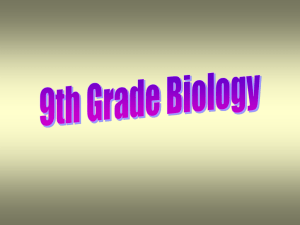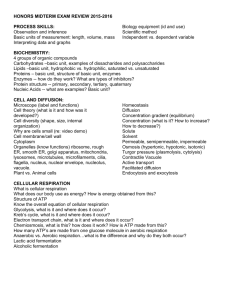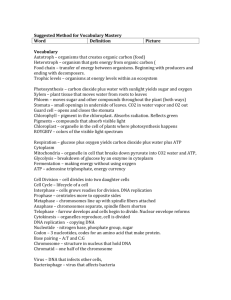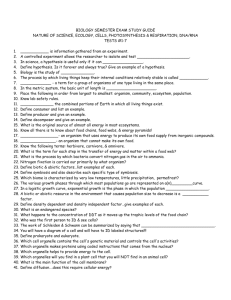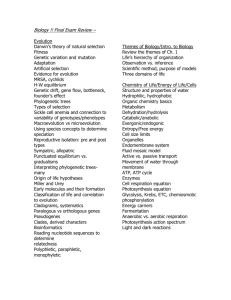Biology Review Part 2
advertisement
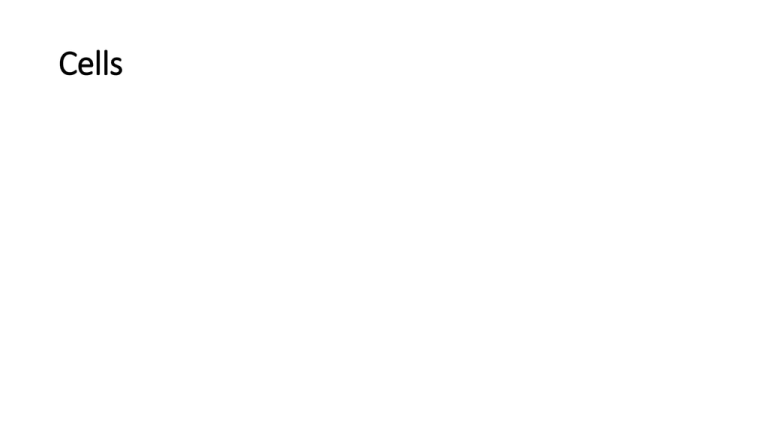
Cells 1. What is the difference in the location of DNA in eukaryotic and prokaryotic cells? •Eukaryotic = DNA in the NUCLEUS •Prokaryotic = DNA in the CYTOPLASM 2. Compare and contrast osmosis and diffusion. •Osmosis, diffusion, and facilitated diffusion are all passive transport (no ATP-energy) •Osmosis requires water moving across a membrane •Diffusion does not require a membrane 3. A researcher wants to study photosynthesis in an organism. What cell structures should the researcher study? •Chloroplasts! 4. List the organelles that are found ONLY in: • Plant cells: chloroplasts, cell wall, LARGE vacuole •Animal cells: lysosomes, centrioles, flagella/cilia 5. Water is moving from low concentration to high concentration! Isotonic = cell is in equilibrium; no net movement of water Hypotonic = cell expands as water moves into the cell Hypertonic = cell shrinks as water moves out of the cell 6. What is the solute and the solvent in the pictures above. •Solute = salt (substance being dissolved) •Solvent = water (substance doing the dissolving) 7. Carbohydrate chain Hydrophilic head Hydrophobic tails Protein Phospholipid bilayer cholesterol 8. What does hydrophilic mean? Hydrophobic? •Hydrophilic = water loving •Hydrophobic = water fearing 9. What role does each play in the cell membrane: • A. Proteins = serve as channels that control movements of substances (facilitated diffusion) • C. Carbohydrate chain = helps cells identify each other •B. Cholesterol = stiffens membrane 10. What does it mean when a cell membrane is “semi-permeable”? • It doesn’t allow all substances through; only certain substances may cross the membrane 11. What is the difference between active and passive transport? • Active transport = requires energy to move substances against the concentration gradient (substances move from LOW to HIGH) •Passive transport = does not require energy because substances are NOT moved against the concentration gradient (substances move HIGH to LOW) 12. What structure in the cell membrane allows for facilitated diffusion to occur? • PROTEINS (serve as channels!) •Facilitated diffusion is still PASSIVE transport 13. State the functions of the following organelles: a. Nucleus= controls cell activities; contains DNA b. Mitochondria = power house/site of cellular respiration in plants AND animals! c. Chloroplast = site of photosynthesis- converts sunlight into usable energy (plants only!) 13. State the functions of the following organelles: d. Ribosomes = site if protein synthesis e. Cell wall = holds the rigid structure of plant cells f. vacuoles = Storage of materials like water, food molecules, inorganic ions, and enzymes 13. State the functions of the following organelles: a. lysosomes= gets rid of waste b. Golgi apparatus = package and delivers proteins c. Endoplasmic reticulum = transports materials 14. State the functions of the following organelles: Cell membrane mitochondria Nucleus chloroplast Cell wall Cellular Respiration and Photosynthesis •1. J. Autotrophs =Organisms that make own food •2. A. Chloroplasts = side of photosynthesis •3. F. Kreb’s Cycle = process occurs in mitochondria •4. D. Glucose = C6H12O6 •5. B. Anaerobic = does not require oxygen •6. C. Aerobic = requires oxygen •7. I. ADP = Adenosine diphosphate •8. E. ATP =Energy storing molecule •9. G. Glycolysis= glucose is broken down into carbon molecules during cellular respiration •10. H. Energy = the ability to do work 2. Why are plants green? •Chlorophyll in plants reflect green wavelengths of light and absorb blue and red. •Grow best under white light which has all wavelengths of light! 3. What is ATP? What is the role of ATP during photosynthesis and cellular respiration? • Molecules that carry energy to be used in chemical reactions • In photosynthesis, helps break down Carbon dioxide molecules into carbon atoms that are used to make sugar (glucose) 4. What are the two stages of photosynthesis? •Light dependent •Light independent (Calvin Cycle) 5. Label reactants and products of photosynthesis: water CO2 sunlight ADP ATP O2 C6H12O6 (glucose) 6. When and why does our body use lactic acid fermentation? •Used when not enough oxygen gets to your cells; uses anaerobic respiration to produce ATP •Lactic acid is a by-product 7. What type of fermentation causes bread to rise? Why? •Alcoholic fermentation = because CO2 gas is produced which makes the bread rise 8. Write the reactants and products of cellular respiration. •Reactants = Glucose and Oxygen (both come from photosynthesis in plants) •Products = ATP, water, Carbon dioxide (CO2 gets used by plants!) 9. Label the stages of cellular respiration and identify the number of ATP produced: Glycolysis Krebs Cycle 2 ATP Electron Transport Chain 34 ATP 10. Which is more effective at creating ATP, aerobic or anaerobic respiration? •Aerobic is more effective (produces 34 ATP instead of 2) Mitosis 1. What is the purpose of mitosis? •To create two identical daughter cells 2. During what phase of mitosis does the DNA replicate? •Interphase! 3. List and describe the phases of mitosis in order •Interphase = DNA replicates, cell performs normal functions •Prophase = DNA condenses into chromosomes; centrioles move to opposite ends of cells, nuclear envelop breaks apart •Metaphase = spindle fibers align the chromosomes in middle of cell 3. List and describe the phases of mitosis in order •Anaphase = Chromosomes start moving to opposite sides of the cell •Telophase = Nuclear envelope forms around chromosomes, chromosomes uncoil •Cytokinesis = Cell split into 2 identical daughter cells DNA 1. What is DNA? •Genetic blueprint of life (stores genetic information) 2. What does DNA stand for? DeoxyriboNucleic Acid 3. What is the monomer of DNA? •Nucleotides! 4. What base pairs match together? Adenine (A) Thymine (T) Guanine (G) Cytosine (C) 5. What would be the complimentary strand to this piece of DNA? •A A T C G C A T A C C G A T = •T T A G C G T A T G G C T A 6. What does it mean for DNA to be semiconservative? Because each half of the original DNA strand become part of each new DNA strand. (it is conserved!) 7. What is the result of DNA replication? •2 new strands of DNA, each with a copy of the original DNA strand 8. What is the function of DNA polymerase? • Joins individual nucleotides to make a new strand of DNA by making sugar-phosphate bonds • Checks each new DNA strand for correctness. 9. What makes up the backbone of DNA? •Deoxyribose sugar bonded to a phosphate group 10. Label the nucleotide: Phosphate group Deoxyribose Sugar Nitrogen Base (ex. Cytosine) 11. Label the diagram of DNA: •1. Nucleotide •2. Hydrogen Bonds •3. Base pairs •4. Deoxyribose Sugar-phosphate backbone

